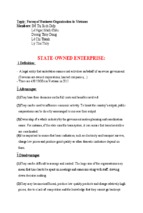Bài tổng hợp bằng tiếng Anh các loại hình doanh nghiệp Việt Nam
Topic: Forms of Business Organization in Vietnam
Members: Đỗ Thị Bích Diệp
Lê Ngọc Minh Châu
Dương Thùy Dung
Lê Chí Thành
Lý Thu Thủy
STATE-OWNED ENTERPRISE:
1.Definition:
- A legal entity that undertakes commercial activities on behalf of an owner government
(Government-owned corporations, limited companies,...)
- There are 4505 SOEs in Vietnam in 2012.
2.Advantages:
(1)They base their decisions on the full costs and benefits involved
(2)They can be used to influence economic activity. To boost the country’s output, public
corporations can be directly encouraged to increase their output.
(3)Ownership of a whole industry by the government makes planning and coordination
easier. For instance, if the state runs the train system, it can ensure that train timetables
are coordinated.
(4)It is important to ensure that basic industries, such as electricity and transport survive,
charge low prices and produce good quality as other domestic industries depend on
them.
3.Disadvantages:
(1)They can be difficult to manage and control. The large size of the organisations may
mean that time has to be spent on meetings and communicating with staff, slowing
down decision making.
(2)They may become inefficient, produce low quality products and charge relatively high
prices, due to a lack of competition and the knowledge that they cannot go bankrupt.
(3)They will need to be subsidized if they are loss making. The use of tax revenue to
support them has an opportunity cost – it could be used to spend on, say, training more
teachers and nurses.
LIMITED LIABILITY COMPANIES
1.Definition:
- A form of business entity that limits the liability of its owners while allowing flexibility
in operation and management and passing through its income to its members with no tax
at the entity level.
- The basic features of a limited liability company are:
+ Its owners have limited liability for the entity's debts and obligations, similar to the
status of shareholders in a corporation
+ Its income and losses are normally passed through to the owners as if it were a
partnership.
2.Advantages:
- A limited liability company (LLC) has many advantages as a form of business entity:
(1)Pass-through taxation - under the default tax classification, profits taxed at the
member level, not at the LLC level (i.e., no double taxation).
(2)Limited liability - the owners of the LLC, called "members," are protected from
liability for acts and debts of the LLC.
(3)With "check-the-box" taxation, an LLC can elect to be taxed as a sole proprietor,
partnership, S-corp or corporation, providing much flexibility.
(4)Can be set up with just one natural person involved or, in some states, one owner
which may be an entity itself.
(5) No requirement of an annual general meeting for shareholders.
(6)No loss of power to a board of directors (although an operating agreement may
provide for centralization of management power in a board or similar body).
(7)LLCs are enduring legal business entities, with lives that extend beyond the illness or
even death of their owners, thus avoiding problematic business termination or sole
proprietor death.
(8)Much less administrative paperwork and recordkeeping.
(9)Membership interests of LLCs can be assigned, and the economic benefits of those
interests can be separated and assigned, providing the assignee with the economic
benefits of distributions of profits/losses (like a partnership), without transferring the
title to the membership interest (e.g., see Virginia and Delaware LLC Acts).
3. Disadvantages:
(1)Earnings of most members of an LLC are generally subject to self-employment tax.
By contrast, earnings of an S corporation, after paying a reasonable salary to the
shareholders working in the business, can be passed through as distributions of profits
and are not subject to self-employment taxes.
(2)Since an LLC is considered a partnership for Federal income tax purposes, if 50% or
more of the capital and profit interests are sold or exchanged within a 12-month period,
the LLC will terminate for federal tax purposes.
(3)If more than 35% of losses can be allocated to nonmanagers, the limited liability
company may lose its ability to use the cash method of accounting.
(4)A limited liability company which is treated as a partnership cannot take advantage of
incentive stock options, engage in tax-free reorganizations, or issue Section 1244 stock.
(5)There is a lack of uniformity among limited liability company statutes. Businesses that
operate in more than one state may not receive consistent treatment.
(6)In order to be treated as a partnership, an LLC must have at least two members. An S
corporation can have one shareholder. Although all states allow single member LLCs,
the business is not permitted to elect partnership classification for federal tax purposes.
The business files Schedule C as a sole proprietor unless it elects to file as a corporation.
(7)Some states do not tax partnerships but do tax limited liability companies.
(8)Minority discounts for estate planning purposes may be lower in a limited liability
company than a corporation. Since LLCs are easier to dissolve, there is greater access to
the business assets. Some experts believe that limited liability company discounts may
only be 15% compared to 25% to 40% for a closely-held corporation.
(9)Conversion of an existing business to limited liability company status could result in
tax recognition on appreciated assets.
JOINT STOCK COMPANY
1.Definition :
- A joint-stock company is a business entity where different stocks can be bought and
owned by shareholders.
- Each shareholder owns company stock in proportion, evidenced by his or
her shares (certificates of ownership).
- In modern-day corporate law, the existence of a joint-stock company is often
synonymous with incorporation (i.e. possession of legal personality separate from
shareholders) and limited liability (meaning that the shareholders are only liable for the
company's debts to the value of the money they invested in the company).
2.Advantages:
(1) Huge Financial Resources : A company can collect large sum of money from large
number of shareholders. There is no limit on the number of shareholders in a public
company. Since its capital is divided into shares of small value even a person of small
means can contribute to its capital by simply purchasing its shares. It facilities the
mobilization of savings of millions for the productive purposes. In addition, a company
can borrow from banks to a large extent and also issue debentures to public.
(2) Limited Liability : The liability of shareholders in a company is limited to the face
value of the shares they have purchased. The limited liability encourages many people to
invest in shares of joint stock companies. If the funds of a company are insufficient to
satisfy the claims of the creditors, no members can be called to pay anything more than
the value of shares held by them.
(3) Perpetual Existence : Due to its separate legal existence, it has perpetual existence.
The life of company is not dependent die or become insolvent. The members of a
company may go on a company. The stability of business is of great importance to the
society as well as to the nation.
(4) Transferability of Shares : The shares if a public company are freely transferable.
This transferability of shares brings about liquidity of investment. It encourages many
people to invest. It also helps a company in tapping more resources.
(5) Diffusion of Risk : In sole proprietorship and in partnership business, the risk is
shared by few persons. But in company, the number of shareholders is large, so many
persons share risk. Therefore, the burden of risk upon any individual is not huge. This
attracts many investors. It enables companies to take up new ventures.
(6) Efficient Management : In company ownership is separate from management.
A company has enough resources to utilize the services of experts and managers who
may be highly specialized in different fields of management. It can attract talented
persons by offering them higher salaries and better career opportunities. The efficient
management will help the company to take balanced decisions and can direct the affairs
of the company in the best possible manner. It also helps to expand and diversify the
activities of the company.
(7) Economies of Large Scale Production : Large scale production of modern days is
the result of company form of organization. This results in economics in production,
purchase, marketing and management. These economies will help company to provide
quality goods at lower cost to the consumers.
(8) Democratic Management : The company is managed by the elected representatives
of shareholders called the ‘directors’. Directors are responsible and accountable to the
general body of shareholders. Decisions are taken by a majority of votes completely
based upon democratic principles. This prevents in mismanagement of a company.
(9) Public Confidence : A company enjoys a greater public confidence and reputation in
the market due to legal control, publicity of accounts and perpetual existence. Audit
of Joint Stock Company is compulsory. A company’s financial accounts and statements
are published , circulated and are open to public inspection. Therefore public have
enough faith in it. So, it can get loan from different financial institutions.
(10) Social Importance : The company provides opportunity to mobilize scattered
savings of the community. It also creates employment opportunities. Due to large-scale
production consumers get cheaper goods. The society is supplied with enough quantity of
goods. Government gets income in the form of taxes.
3. Disadvantages:
(1) Difficulty in Formation : A company is not easy to form and establish. A number of
persons should be ready to associate for getting a company incorporated. It requires a lot
of legal formalities to be performed. The shares will have to be sold during the prescribed
time. It is both expensive and risky.
(2) Lack of Secrecy : A company has to observe many legal formalities. Most of the
business activities are decided through meetings. Profit and Loss Accounts and Balance
Sheet are required to be published. So trade secrets cannot be maintained.
(3) Delay in Decisions : In company decisions making process is time consuming. All
important decisions are made by either Board of Directors of by General Annual
Meetings. So many opportunities may be lost due to delay in decision making.
(4) Separation of Ownership and Management : A company is owned by shareholders
but managed by directors. The shareholders play an insignificant role in the working of
the company. Though directors are owners of some qualification shares only, yet the
result of their activities are to be borne by all shareholders. The profit of the company
belongs to shareholders and the Board of Directors is paid only on a commission. There
is no direct relationship between efforts and rewards. So the management does not take
personal interest in the workings of company. Hence, they may work against the interest
of vast majority of shareholders.
(5) Speculation in shares : The Joint Stock Companies facilitate speculation in the
shares at stock exchanges. It has been found that even the directors and the managers of
the company indulge in manipulating the value of shares to their advantage. When they
want to purchase the shares they lower the rate ofdividend and when they want to dispose
of the shares they declare dividendsat a higher rate.
(6) Oligarchic Management : The shareholders who are the real owners do not have
much voice in the management. A handful of shareholders, which also manage the affairs
of the company, are able to have control over it. Theoretically the company is
democratic, but in practice it is mostly a case of oligarchy (Rule by few). A few persons
hold power and control and try to exploit the majority. Thus, it does not promote the
interest of the shareholders in general.
(7) Excessive Regulation : A company has to observe excessive regulations imposed by
the law of the country. The excessive regulations are made with a view to protect the
interest of the shareholders and the public but in practice they put obstacles in their
normal and effective working. A lot of precious time, efforts, and financial resources are
wasted in complying with statutoryrequirements.
(8) Conflict of Interest : In a company there are many parties whose interest may clash
and the result may be conflict of interests. The management, the shareholders, the
employees, the creditors and the government may have their own individual interests.
Thus, a permanent type of conflict of interests may continue to exist in the companies.
These conflicts generally lead to inefficiency in the management and reduce employee
morale.
(9) Neglect of Minority : All major issues in company are decided by the shareholders
having majority of them. Majority group always dominate over the minority group whose
interest are never represented in the management. The company act provides measures
against oppression of minority, but the measures are not very effective.
PROPRIETORSHIP:
1. Definition
- Proprietorship companies are owned and run by only one person
- There is no legal distinction between the owner and the business
- They receives all profits from the business activities
- Proprietorship have unlimited responsibility for all losses and debts.
2. Advantages:
(1)The company’s owner has all control of company operating activities.
(2)They have simple structure and aren’t complicated than corporations.
(3)They are trustworthy for their partners because of unlimited responsibility.
3. Disadvantages:
(1) High risk
(2)The owner has full responsibility for all business activities
(3) They have no legal distinction and can’t join the stock market
PARTNERSHIP:
1.Definition:
- A partnership is an arrangement in which two or more individuals share the profits and
liabilities of a business venture.
- 2 types of partnership:
+ Limited partnerships: Not every partner is necessarily involved in the management and
day-to-day operations of the venture.
+ General partnerships: normaly share liabilities and profits equally, some partners have
unlimited liability.
2.Advantages:
(1)Capital – Due to the nature of the business, the partners will fund the business with
start up capital. This means that the more partners there are, the more money they can
put into the business, which will allow better flexibility and more potential for growth.
It also means more potential profit, which will be equally shared between the partners.
(2)Flexibility – A partnership is generally easier to form, manage and run. They are less
strictly regulated than companies, in terms of the laws governing the formation ( and
because the partners have the only say in the way the business is run (without
interference by shareholders) they are far more flexible in terms of management, as long
as all the partners can agree.) cái này thì để giải thích ngoài, ko cần cho vào slide
(3)Shared Responsibility – Partners can share the responsibility of the running of the
business. This will allow them to make the most of their abilities.
(4)Decision Making – Partners share the decision making and can help each other out
when they need to. More partners means more brains that can be picked for business
ideas and for the solving of problems that the business encounters.
3.Disadvantages:
(1)Disagreements – One of the most obvious disadvantages of partnership is the danger
of disagreements between the partners. (Obviously people are likely to have different
ideas on how the business should be run, who should be doing what and what the best
interests of the business are. This can lead to disagreements and disputes which might
not only harm the business, but also the relationship of those involved. This is why it is
always advisable to draft a deed of partnership during the formation period to ensure
that everyone is aware of what procedures will be in place in case of disagreement and
what will happen if the partnership is dissolved.)
(2)Agreement – Because the partnership is jointly run, it is necessary that all the partners
agree with things that are being done. This means that in some circumstances there are
less freedoms with regards to the management of the business. Especially compared to
sole traders. However, there is still more flexibility than with limited companies where
the directors must bow to the will of the members (shareholders).
(3)Liability – Ordinary Partnerships are subject to unlimited liability, which means that
each of the partners shares the liability and financial risks of the business. Which can be
off putting for some people. This can be countered by the formation of a limited liability
partnership, which benefits from the advantages of limited liability granted to limited
companies, while still taking advantage of the flexibility of the partnership model.
(4)Taxation – One of the major disadvantages of partnership, taxation laws mean that
partners must pay tax in the same way as sole traders.They are also required to register
as self employed with HM Revenue & Customs. The current laws mean that if the
partnership (and the partners) bring in more than a certain level, then they are subject to
greater levels of personal taxation than they would be in a limited company. This means
that in most cases setting up a limited company would be more beneficial as the taxation
laws are more favourable
(5)Profit Sharing – Partners share the profits equally. This can lead to inconsistency
where one or more partners aren’t putting a fair share of effort into the running or
management of the business, but still reaping the rewards.
*** Examples of each group will be presented in the speech.
- Xem thêm -




















